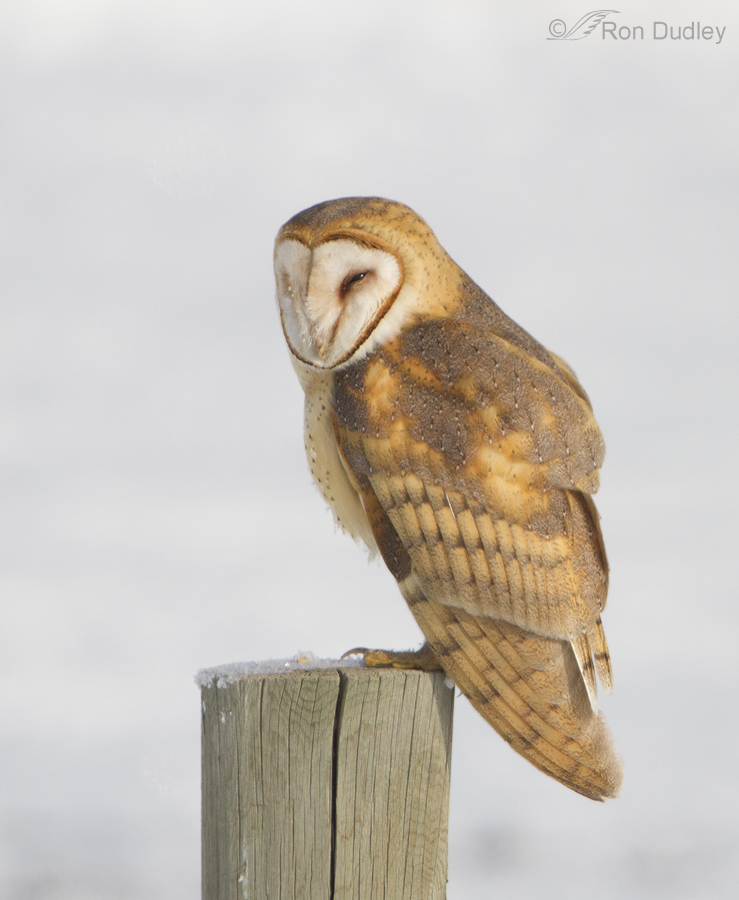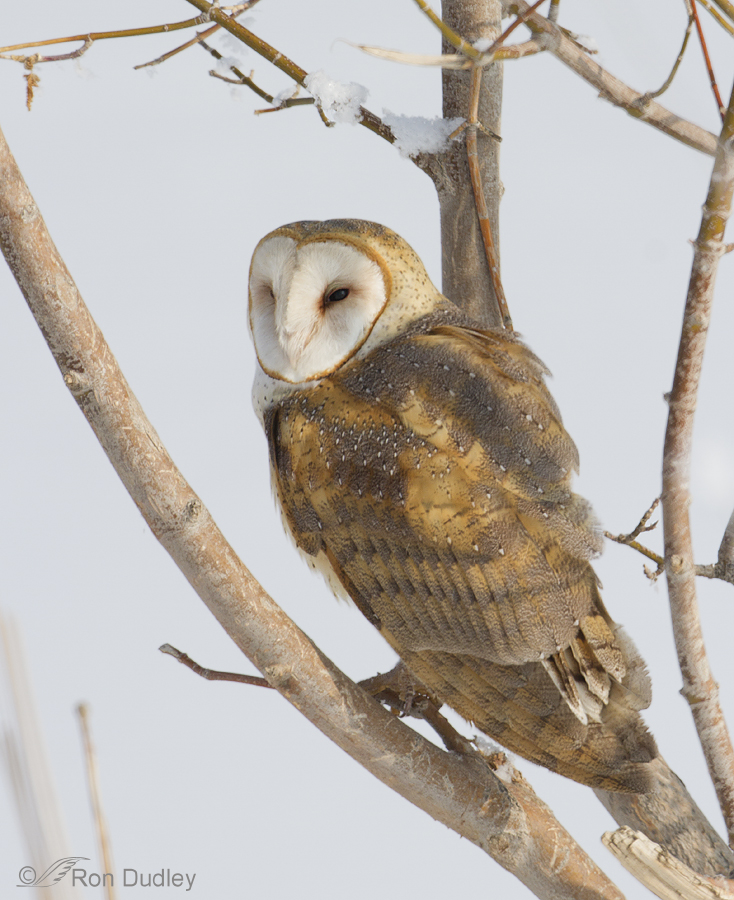Most of the images of Barn Owls I post show them in flight but I also enjoy the different perspective one can get while they’re perched. Each of these shots was taken ten months ago when the January snows were deep and persistent in the background of nearly all my images.
1/3200, f/6.3, ISO 500, 500 f/4, 1.4 tc, natural light, not baited, set up or called in
Perched shots often show some field marks better than when the bird is in flight. Here the large head, lack of ear tufts, conspicuous heart-shaped facial disc, short tail and long wings stand out. The size of their wings gives Barn Owls low wing-loading and permits them to carry heavy prey at slow speeds (though their most common meal is the relatively small vole).
This bird was photographed on a very cold morning and the owl has frost on its face.
1/1600, f/8, ISO 400, 500 f/4, natural light, not baited, set up or called in
Here you get a better look at the relative length of tail and wing flight feathers and the small (for an owl) size of the eye. Unlike many owls, Barn Owl eyes are dark – almost black. The bill is ivory-colored though much of it is hidden by feathers. I like the clean look at the bird in the first image with the owl on an old weathered post but still prefer the natural perch in the second, despite the more cluttered setting.
I haven’t seen a Barn Owl out in the open for many months. Winter snows should bring them out but I hope they have a better winter this year than they did last.
Ron




We’re still trying to find breeding Barn Owls in our local county to include in the Breeding Bird Atlas. Hopefully, as our weather (finally) is turning a bit cooler, they’ll start sounding off during the night. Now, if I can just make myself go “hunting” in the middle of the night!
Wonderful photographs, Ron! Love the details you mentioned that are so visible in your images.
Beautiful birds. I hope they have a better winter, too. Thank you for these lovely pics.
Thanks, everyone – for all the nice comments.
Debbie – there’s many places for these birds to seek shelter during the day but when it’s this cold and with this much snow the owls have a hard time catching enough voles during the night so they hunt during the day. They takes breaks now and then and that’s what these owls were doing.
Patty, a “sprinkling of stardust – a very descriptive and appealing phrase for these markings on the owls.
Bill – thanks once again for contributing your expertise for all of us.
The lower image appeals more than the upper one, and I can’t work out exactly why – maybe the way the branches echo the colours of the bird?
Beautiful photos of a beautiful bird!
I love Patty’s description. Subtle, beautiful, wonderful birds. My greedy self is more than a little jealous of anyone who sees them – and so very grateful that you share the magic.
Our North American Barn Owl is the only owl in the family Tytonidae and is a subspecies of Tyto alba. All our other species are from the family Strigidae. The Barn Owl is found on all continents except Antartica and is really a tropical species closely related to the Grass owls. Their color patterns are more beneficial to more tropical regions and the vegetation found in those habitats. Their underside coloring (almost exclusively white) aids is helping them disappear to the vision of their potential prey considering the background of the daylight (they are not exclusively nocturnal by any means) but rather crepuscular. They can also be sexed most of the time by some of the barring on the wing plumage. The wing loading Ron spoke of does allow for them to successfully hunt many rat species found in various habitats around the world. Their biggest claim to fame arguably is their hearing. Perhaps the best of any raptor in the world.
Bill
Magnificent photos! Such beautiful owls. Is it that open there that there is no place for these owls to seek shelter during the day?
What Betsy said about the color of the branches is one reason the photograph is so appealing.
“Stardust” – the perfect word, Patty. Ron, I was going to ask about the camouflage benefits of those markings. Also wanted to note that the color range of the branches in your second photo matches that of the bird and enhances the beautiful coloration.
They are such beautiful creatures!! Thanks for taking the time to let us enjoy them up close.
Beautiful colors on the Barn Owls feathers, an artist challenge to duplicate those colors!! Great Shot, Ron, thanks for sharing.
These are incredible shots! I love the subtle colors of these birds and the stardust their feathers are sprinkled with. With vanishing habitat, both hunting and nesting space, they need a lot of luck…
Sensational shots Ron! Thanks for sharing!
Charlotte